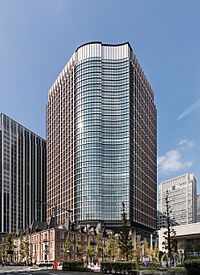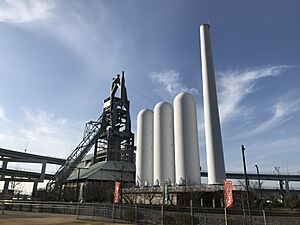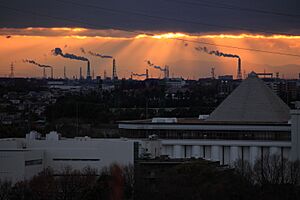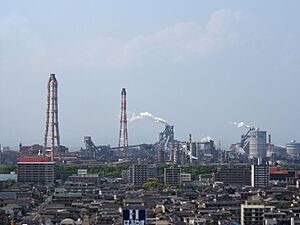Nippon Steel facts for kids
Logo used since 2019
|
|

Marunouchi Park Building, headquarters of Nippon Steel
|
|
|
Native name
|
日本製鉄株式会社
|
|---|---|
|
Romanized name
|
Nippon Seitetsu kabushiki gaisha |
|
Formerly
|
Nippon Steel & Sumitomo Metal Corporation (2012–2019) |
| Public | |
| Traded as | TYO: 5401 NAG: 5401 FSE: 5401 SSE: 5401 TOPIX Large70 component |
| Industry | Steel |
| Predecessors |
|
| Founded | October 1, 2012 |
| Founders |
|
| Headquarters | Marunouchi,
,
Japan
|
|
Key people
|
Eiji Hashimoto (Chairman & CEO) |
| Revenue | |
|
Operating income
|
|
| Total assets | |
| Total equity | |
|
Number of employees
|
106,068 (2023) |
| Subsidiaries | Nippon Steel Engineering Nippon Steel Materials Nippon Steel Chemical U.S. Steel |
Nippon Steel Corporation (which means "Japan Steel Corporation") is Japan's biggest company that makes steel. Its main office is in Chiyoda, Tokyo, Japan. The company makes many different steel products. It also works in engineering, chemicals, and computer systems. Nippon Steel is the largest producer of raw steel in Japan. It is also the fourth largest steel producer in the world.
This company has been known by the name Nippon Steel three times. Each time, the name was slightly different. The first company, called Japan Iron & Steel Co., Ltd., started in 1934. It later split into two companies in 1950. These two companies joined back together in 1970 to form Nippon Steel Corporation. In 2012, it merged with another company called Sumitomo Metal Industries. The company's English name went back to Nippon Steel Corporation in 2019.
Contents
The Story of Nippon Steel
How It All Began

Nippon Steel's history goes back to 1934. That's when Japan Iron & Steel Co., Ltd. was created. This happened by combining the Yahata Steel Works with other steel factories. In 1950, the company's steel-making parts split into two new companies. These were Yawata Iron & Steel and Fuji Iron & Steel.
These two companies then merged again in 1970. They formed the Nippon Steel Corporation we know today. In the early 1980s, the company faced some tough times. They had to make less steel and their profits went down. Instead of laying off workers, they found creative solutions. For example, they started a mushroom farm. This farm used the extra heat from the steel furnaces to grow mushrooms. This helped keep employees working.
Facing Challenges and Changing Direction
In the 1980s, the entire Japanese steel industry struggled. Other countries, like South Korea, could make steel much cheaper. This meant less business for Japanese companies. Nippon Steel even lost money in 1986. This made them decide to try new things. They wanted to move away from just making steel. They also needed to find new jobs for thousands of employees. Many steel furnaces were closing down.
Between the 1980s and 1990s, Nippon Steel closed furnaces at three of its main locations. These were Kamaishi (in 1989), Sakai (in 1990), and Hirohata (in 1993).
Trying New Things
Nippon Steel started to explore different businesses. They got involved in semiconductors (parts for electronics) and other electronics. They even opened a theme park called Space World. The company also worked on software and even human resources products. One interesting attempt was Librex Computer Systems. This was Nippon Steel's try at selling laptop computers overseas. It lasted from 1990 to 1993.
The company faced losses again in 1993. More employees had to move to new jobs. But by cutting costs, the company became healthy again in 1995. Later, strong demand for steel from China helped the company make profits again.
Big Mergers and Today
In 2011, Nippon Steel announced a big plan. They would merge with Sumitomo Metal Industries. Nippon Steel made about 26.5 million tons of steel each year. Sumitomo made about 11 million tons. Together, the new company would make almost 37 million tons of raw steel every year. This would make them the second largest steelmaker in the world.
On October 1, 2012, the merger officially happened. The new company was called Nippon Steel & Sumitomo Metal Corp. On April 1, 2019, the company's Japanese name changed back to Nippon Steel Corporation.
In May 2020, Nippon Steel announced it would stop using some furnaces. One furnace was closed permanently. This happened because the company had lost money in 2019. On June 18, 2025, Nippon Steel completed a big purchase. They bought US Steel for about $14.1 billion.
Where Nippon Steel Makes Steel
Nippon Steel has many important factories and locations.
Here are some of their major plant locations in Japan:
- Muroran, Hokkaido
- Kamaishi, Iwate Prefecture
- Kimitsu, Chiba Prefecture: Kimitsu Steel Works
- Tokyo
- Tōkai, Aichi Prefecture (Nagoya)
- Sakai, Osaka Prefecture
- Himeji, Hyōgo Prefecture (Hirohata)
- Hikari, Yamaguchi Prefecture – makes steel pipes
- Kitakyushu, Fukuoka Prefecture (Yahata)
- Oita, Oita Prefecture
After the merger with Sumitomo, more locations were added:
- Kashima, Ibaraki
- Jōetsu, Niigata (Naoetsu)
- Amagasaki, Hyōgo
- Osaka
- Wakayama
- Kitakyushu, Fukuoka (Kokura)
Working with Other Companies
Nippon Steel also works with other companies around the world. These are called joint ventures.
- In New Carlisle, Indiana, USA, they have a joint venture that started in 1991.
- AM/NS Calvert is in Calvert, Alabama. Nippon Steel and ArcelorMittal bought this facility together in 2014. It makes steel products for North America.
- Nippon Steel Trading Co., Ltd. has a joint venture in Indonesia. They make steel sheets for cars.
- POSCO-Nippon Steel RHF Joint Venture is in Pohang, South Korea. This company recycles waste from steel plants.
- In 2023, Nippon and POSCO made an agreement with Teck Resources. They exchanged interests in some Teck operations for a share in Elk Valley Resources.
Caring for the Environment
Nippon Steel works to be more environmentally friendly.
- In 2005, they planned to recycle more waste plastics into coke. Coke is an important material for making steel. They invested money to add equipment at their factories for this.
- In 2006, Nippon Steel and Mitsubishi Heavy Industries made a new strong steel. This steel was first used for the hulls of container ships. It allowed ships to be just as strong but use less steel. This helps ships use less fuel and be better for the environment.
- Also in 2006, Nippon Steel started a project to turn waste food into ethanol. Ethanol can be used as fuel. They worked with Kitakyushu City to collect food waste. They also used waste heat from an existing incinerator. This helped save energy and reduce costs.
Other Interesting Connections
- Kashima Antlers is a famous Japanese football (soccer) club.
- NS Solutions is a company that provides computer system solutions.
See also
 In Spanish: Nippon Steel para niños
In Spanish: Nippon Steel para niños






